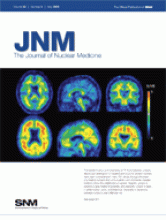TO THE EDITOR: I read with interest the recent article by Tuttle et al. (1). For years, patients have been prepared for 131I administration after thyroid cancer surgery. It is believed that the increase of thyroid-stimulating hormone concentration by either thyroid hormone withdrawal (the traditional method of preparation) or injection of recombinant human thyroid-stimulating hormone (rhTSH) promotes 131I uptake and retention in remaining radioiodine-avid cells. It is somehow also believed that the same patient preparation applies regardless of whether 131I is given for diagnosis or for therapy. There is, however, no in vivo evidence that the thyroidal absorbed dose rate or dose per unit of administered therapeutic 131I activity (or any other pivotal radiobiologic factor) has clear benefits over the traditional patient preparation. On the contrary, there are data in contrast to the common paradigms (2–6).
An R × C contingency table is a table with R rows and C columns. The χ2 test is used to analyze the relationship between 2 discrete variables, where one variable, depicted in the rows, has R categories and the other variable, depicted in the columns, has C categories. Consequently, the P values given in the contingency tables of Tuttle et al. (1) are correct, but their use and interpretation for a single C category are not. For instance, although short-term recurrence rates were similar between the rhTSH and withdrawal groups (P = not significant), the best clinical outcome (no clinical evidence of disease) was significantly higher in the rhTSH group than in the withdrawal group (the corresponding P values are not the 0.10 and 0.021 reported in Tables 5 and 6, respectively), regardless of the thyroglobulin cutoff value (1). Furthermore, it seems doubtful whether the outcome category “thyroid bed uptake only” should have been included in contingency tables containing a total of 394 patients, of whom only 291 (73.9%) underwent follow-up diagnostic whole-body scanning (1). These issues should be the subject of a published erratum, as should “radioactive ablation of iodine remnants” on the sixth page of the article, and “n = 394” instead of the correct n = 371 in Table 7 (1).
Most of the study limitations have already been discussed by the authors (1). In an effort to explain the significantly higher rate of no clinical evidence of disease in the rhTSH patients than in the withdrawal patients, i noted that the former received a “slightly” higher administered 131I activity (in fact, it was not slightly but significantly higher, at P = 0.01), were significantly older (P = 0.03), had a longer surgery-to-ablation interval, and underwent an essentially different preparation (1). Interestingly, the absorbed dose per unit of administered 131I activity in the thyroid remnant was found to correlate positively with age in our patients after thyroid hormone withdrawal.
I believe, in some contrast to the presented methodology and conclusions (1), that high success rates for ablation and low recurrence rates are achievable in totally or near-totally thyroidectomized patients without significantly compromising the patient's quality of life. These results can be achieved by a single administration of less than 2 GBq of 131I and by thyroid hormone supplementation started or restarted within 10–20 d after surgery or thyroid hormone withdrawal (2–6). Such an approach is particularly reasonable when the overall costs of rhTSH-aided therapy (in certain countries or certain patients) are much higher than those of thyroid hormone withdrawal. However, the optimal patient-specific timing and dosage for 131I treatment of thyroid cancer have yet to be determined.
Footnotes
-
COPYRIGHT © 2009 by the Society of Nuclear Medicine, Inc.







